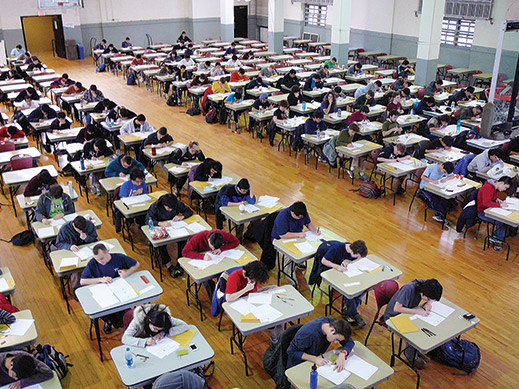Taking the Putnam
It is December 5, 2013, and I am standing among the 129 MIT undergraduates who have roused and dressed and transported themselves to the gym turned exam room in Walker Memorial on this Saturday morning. Outside, it’s a wintry day, but the weather is inconsequential: today will be devoted to math problems.

This is the 74th William Lowell Putnam Mathematical Competition, the country’s most prestigious collegiate math contest. The top five competitors, named as Putnam Fellows, tend to become titans of academia. Past fellows have gone on to be Nobel laureates and MacArthur geniuses. Physicist Richard Feynman was a Putnam Fellow; famed mathematician John Nash only placed in the second five.
The Putnam is the denouement of the story of ambitious American mathletes. The story starts in middle school and builds to the International Math Olympiad, the World Cup of high school math. It is the final competitive hurrah for the whizzes, wunderkinds, and prodigies entering the world of mature mathematics, where big questions take years, not hours, to solve.
In the Walker gym, students wait in line for manila test packets or carve out space at desks, drinking coffee or Snapple and eating bagels and granola bars. Bedhead is the coif en vogue. Couture slants heavily toward T-shirts from math contests or tech companies. The large windows drench the gym with morning sunlight.
Three of last year’s five Putnam Fellows were MIT students: Mitchell Lee ’16, Benjamin Gunby ’15, and Zipei Nie ’15. They all return to compose the MIT team. Bobby Shen and David Yang, two freshman newcomers who have been elite competitive mathletes—and rivals—since middle school, are also here.
Professor Henry Cohn, a test proctor, asks students to find their registration numbers posted on the wall: “It’s a number between one and infinity.” Pre-contest banter echoes through the gym: “Last Putnam ever.” “Last math contest ever.” “If I wrote down the wrong ID number I’d probably get a higher score.” “Yeah, if it was Ben Gunby’s number.”
One by one we get our packets and find seats. I’m a math major, but my last competitive math experience was placing second in a fifth-grade regional prelim of a Washington state contest called “Math Is Cool.” So I am comforted that the median score is, in Cohn’s words, “a small single-digit number out of 120.” For mathematical mortals, there is no way to bomb the Putnam: if you get zero, you are average.
The room fills with the white noise of writing and fidgeting, occasionally cut by the shearing of the electric pencil sharpener. One test taker folds his hands in front of his eyes, squinting, a bagel hanging from his mouth. Before long, at least one kid will fall asleep. There are fewer than five women in the room (three female students have been Putnam Fellows a total of four times, all since 1996).
The first question asks us to write a proof involving a regular icosahedron, a convex polyhedron having 12 vertices and 20 faces—a Dungeons & Dragons die. It is helpful that the logo of the Mathematical Association of America, an icosahedron, is depicted at the top of each page. Assisted by the picture, I write down a solution. But that’s little solace: the six problems on the morning’s test, and the six in the afternoon, ascend in difficulty. In fact, when Cohn calls pencils down at the end of the three-hour session, I’ve only got answers for problem one and part of problem two.
The afternoon session is more subdued. Many students turn in their tests early and leave. Before the session is half finished, the sun has set and the only light comes from the gym’s fluorescent lamps. At last Cohn calls time, and it seems everyone is ready to be done with math for the day.
When the results come out in March, Lee, Nie, Shen, and Yang will claim four of the five Fellow spots, securing first place for MIT. Gunby will place in the top 25, and 57 MIT students will finish in the top 201 in another dominant year for the Institute. The Fellows are applauded; the rest of us watch from the sidelines and wonder whether we’re witnessing young mental giants who will redraw the borders of human knowledge or just some kids who did well on a math test.
Zach Wener-Fligner ’14 will join the Atlantic as a media fellow in July.
Keep Reading
Most Popular
Large language models can do jaw-dropping things. But nobody knows exactly why.
And that's a problem. Figuring it out is one of the biggest scientific puzzles of our time and a crucial step towards controlling more powerful future models.
How scientists traced a mysterious covid case back to six toilets
When wastewater surveillance turns into a hunt for a single infected individual, the ethics get tricky.
The problem with plug-in hybrids? Their drivers.
Plug-in hybrids are often sold as a transition to EVs, but new data from Europe shows we’re still underestimating the emissions they produce.
Stay connected
Get the latest updates from
MIT Technology Review
Discover special offers, top stories, upcoming events, and more.